BY POND. STEVE POND.
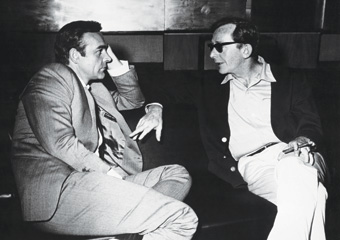 BONDING: Lewis Gilbert shares a quiet moment with Sean Connery on the
BONDING: Lewis Gilbert shares a quiet moment with Sean Connery on the
set of You Only Live Twice, but one of his toughest tasks was getting
Connery to walk down a Japanese street without being mobbed.
(Photo Credit: 1967 Danjaq, LLC and UA Corp)
We're talking about the James Bond movies, so of course we'll need to start with an action scene.
It takes place in 2002 at Pinewood Studios, outside London, where so much Bond history has occurred. Inside what is called "the Bond stage," actor Pierce Brosnan hangs from a huge ice wall constructed by production designer Peter Lamont for Die Another Day. Brosnan's Bond is clinging to a rocket-powered ice speedster he's used to escape from the bad guys. In a matter of seconds he'll need to pry the hood off the car and use it to windsurf the enormous wave created when the glacier wall, from which he's dangling, slides into the sea. Brosnan settles into place, director Lee Tamahori checks his monitor—and then, suddenly, Tamahori starts laughing.
"I was in the middle of directing, Pierce was hanging upside-down off a glacier, and I just started cracking up," remembers Tamahori of that day on the set. "Pierce asked, 'What's so funny?' And I said, 'Sorry. I suddenly had a reality check and realized I was on a Bond movie.'"
A Bond movie—the phrase conjures up the high-tech, high-profile, big-budget world of a suave British secret agent with a license to kill, a way with the ladies, and a knack for fighting and wisecracking his way through scrapes that can be brutal, thrilling and outlandish all at once. Since 1962, the Bond series has presented its directors with the kind of challenges unique to the biggest, longest-running, highest-grossing series in film history. Our conversations with all eight living Bond directors touched on staging everything from huge action sequences to intimate poker games; keeping the franchise vital at times when it seemed to be getting stale; honoring the past, and looking to the future of an enterprise that has always been a singular entry on a director's resume. "I've directed 40 films," says Lewis Gilbert, who at 88 is the oldest-living Bond director. "And of all the films I've made, people are always just interested in the three Bonds. You could go anywhere, and people say, 'Oh, you're a film director? What have you done?' You've only got to say, 'I've done James Bond,' and they go practically barmy. All the films I got Academy nominations for, nobody knows them, nobody mentions them. But James Bond—that's your passport."
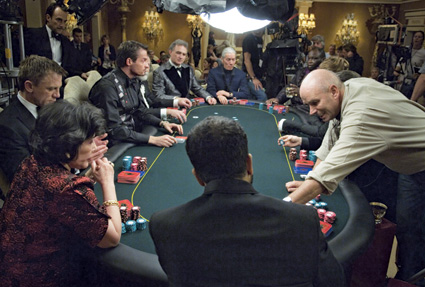 HIGH STAKES: Martin Campbell (right) says one of the hardest scenes to stage
HIGH STAKES: Martin Campbell (right) says one of the hardest scenes to stage
was 10 people around a poker table in Casino Royale. Daniel Craig (left) made
his debut as Bond in this film. (Photo Credit: 2006 Danjaq, LLC and UA Corp)
Over the 47 years since Ian Fleming's secret agent first appeared on the screen in Dr. No, six actors have played the role in what is now 22 movies. Only slightly more directors—10—have taken the helm: six Brits (Gilbert, Guy Hamilton, John Glen, Michael Apted and the late Terence Young and Peter R. Hunt), one Canadian (Roger Spottiswoode), two New Zealanders (Martin Campbell and Tamahori) and one of German-Swiss extraction (Marc Forster). Glen has directed the most with five, Hamilton did four, Gilbert and Young three, Campbell two, and the rest one each.
For most, it starts with a call from the Broccoli family. Albert "Cubby" Broccoli produced the first 16 Bond movies (some with original partner Harry Saltzman). Since 1995, the job has been handled by his daughter and stepson, Barbara Broccoli and Michael G. Wilson. Their company, Eon Productions, wields enormous control over the franchise—and Eon knows, says Tamahori, how to make an impression.
"Michael and Barbara flew me to London," he says of his introduction to the company. "I got to Heathrow Airport and jumped into a Rolls-Royce with 'EON' on the number plate, and was handed a script by the driver. The script had 'For Your Eyes Only' or something on it, and I could only read it in the car on the way to Eon Productions. It was absolutely hilarious and wonderful."
The directors chosen by the Broccolis have ranged from action film vets like Glen, who'd already served as an editor and second unit director on three early Bond films, to several with little or no experience on big-budget, stunt-heavy extravaganzas. "My first feeling was, what the hell am I going to do?" says Gilbert, whose best-known film was the 1966 Swinging London chronicle Alfie before he was asked to direct You Only Live Twice (1967). "There had been four very good films before me, so how do I make it any different? I had a long talk with Cubby, and he said, 'Oh, I'm sure you'll find some way of making it a bit better or a bit different.' And I had already made 10 or 12 films, so I was fairly confident I could do something with it."
What makes the job trickier, says DGA President Michael Apted, director of The World Is Not Enough (1999), is that every Bond director knows that while you can bring some of your own ideas and style to the project, you also have an obligation to the icons of the Bond world. "It's exciting and scary," he says. "You know there's a huge audience that's out there, and you have to deliver certain elements. Those elements include the style of the film, the swagger of Bond, the girls, the one-liners, the gadgets."
After a test screening indicated that viewers were disappointed that his film didn't have a bigger action sequence before the opening credits, Apted accelerated the pace and shifted the credits so that they followed a dramatic chase along the Thames. "As a director you want to leave your fingermarks on it," he says. "But you have to accept that certain things are expected of you. It's an incredibly durable franchise, and I learned to respect it."
TERENCE YOUNG
Dr. No (1962)
From Russia with Love (1963)
Thunderball (1965)
GUY HAMILTON
Goldfinger (1964)
Diamonds Are Forever (1971)
Live and Let Die (1973)
The Man with the Golden Gun (1974)
LEWIS GILBERT
You Only Live Twice (1967)
The Spy Who Loved Me (1977)
Moonraker (1979)
PETER R. HUNT
On Her Majesty's Secret Service (1969)
JOHN GLEN
For Your Eyes Only (1981)
Octopussy (1983)
A View to a Kill (1985)
The Living Daylights (1987)
Licence to Kill (1989)
MARTIN CAMPBELL
GoldenEye (1995)
Casino Royale (2006)
ROGER SPOTTISWOODE
Tomorrow Never Dies (1997)
MICHAEL APTED
The World Is Not Enough (1999)
LEE TAMAHORI
Die Another Day (2002)
MARC FORSTER
Quantum of Solace (2008)
At times, different directors have taken dramatically different approaches to the challenge of Bond. Hamilton talks about keeping a light touch ("It's important to be a little bit tongue-in-cheek, because you can't take the nonsense too seriously"), while Glen remembers trying to play up "gritty realism" and "bring the series back to its origins as a thriller." Apted was adamant that aside from his director of photography and editor, he wanted a crew "who had worked in this environment and could help in the areas where I was vulnerable." Marc Forster, who directed Quantum of Solace, says he wanted "a fresher approach" and thought it was important that his creative team, apart from some second unit directors, had not worked on previous Bonds.
Still, practically all Bond directors agree on a few things. For starters, you work under a tight schedule and rarely have much time in postproduction. Hamilton says he had four weeks to edit Goldfinger (1964), and composer John Barry was "going ape" because he wasn't getting scenes in time. Spottiswoode previewed Tomorrow Never Dies (1997) only 10 days after he finished shooting, and began locking the negative a week after that. "On a film like that, some of the scenes take hours of preparation for each shot," he says. "If you have a motorcycle or a scooter, as I did, to get about the studio lot, you can set up a shot and then you're in the cutting room for two hours."
Complicating matters is the fact that the Bond films almost always need revising or rewriting before production starts. Tomorrow Never Dies was a particularly tricky case. The script originally dealt with the transfer of Hong Kong from the British to the Chinese—a problematic premise, since the actual handover was to take place during the film's production. Spottiswoode says that MGM went to Henry Kissinger's consulting firm, Kissinger Associates, for an opinion on the script's potential accuracy. When Kissinger's response was along the lines of "Who knows?" the studio ordered the filmmakers to rewrite the entire script but to keep it quiet, lest the 4,000 theaters already committed to showing the film get cold feet.
The story's villain, a Rupert Murdoch-type media baron, was retained, along with the script's opening scenes. Everything else, however, had to go. "I'm not sure if I should be telling this story, because I don't know if Barbara's ever talked about it," Spottiswoode says, laughing. "But I knew that lots of big writers who don't write Bond films have great Bond ideas. So we picked 10 really good screenwriters and said to them, 'Why don't you come to London and spend a week in the Dorchester with your significant other? We'll give you a lot of spending money, like $1,000 a day, and all you have to do is show up in the morning and swap ideas. You won't get paid, but you'll have a really nice one-week vacation in London, and together we'll cough up the story.' Sure enough, two weeks later, we got 10 writers who would cost an absolute fortune if we'd hired them. They gave us three hours each morning, and by the end of that week we had a very good outline." Another writer (who opted not to take screen credit) worked from the outline over the next 10 weeks. "By the time we started shooting," Spottiswoode says, "I think we had a pretty good script."
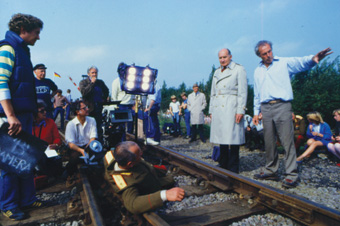 LEADER OF THE PACK: John Glen, laying tracks on Octopussy, directed
LEADER OF THE PACK: John Glen, laying tracks on Octopussy, directed
five Bond films in the '80s using special effects he says were available
in Buster Keaton's day. (Photo Credit: 1983 Danjaq, LLC and UA Corp)Even a good script, though, can't keep the job from occasionally overwhelming a director who has to control a huge production that includes second units, model units, underwater units, aerial units and special effects.
"It was terrifying, logistically," says Apted, who at one point was shooting in Istanbul and speaking to his model unit in the Caribbean when he realized that the model unit was working on the shot that would immediately follow the one Apted was currently shooting. "During preparation, there were times when I thought, I'm never going to get through this, I'm never going to carry all this in my head. But if you pay attention during preproduction, things begin to fall into place."
The good news is that the Broccolis make sure their directors have little interference from the studio, and if you really want to do something, there's probably enough money to pull it off. "My fondest memory was of a car chase," says Tamahori. "We'd come up with this chase on ice with the cars spinning, skidding; glaciers; teetering on the edge—all that kind of outrageous stuff. But there was no finish to it."
At the same time, production designer Peter Lamont was beginning to build an enormous set, a palatial Arctic Circle hotel made entirely of ice. "I thought, can't we make more out of this set? Why don't we finish the car chase by driving all around this ice palace and smashing it up? What that meant, of course, was that it was a huge, expensive rebuild." Overnight, Lamont ran the numbers and came up with an estimate for what it would cost to reinforce the entire set with 61 miles of tubular steel. The next morning, Tamahori met with Broccoli and Wilson and pitched what would be a roughly $1.5 million upgrade.
"The cost increase made it a [$3 million] set, but the astonishing thing was that they didn't even blink," says Tamahori. "They said, 'Sounds great, let's go for it.'"
So, on Bond film after Bond film, on the backlot at Pinewood and in exotic locations around the world, the directors went for it. In the early '70s, Hamilton saw a stunt driver on TV drive a car around a French aerodrome on two wheels, thought it looked Bondian, and conjured up a sequence in Diamonds Are Forever (1971) in which Bond escapes the bad guys by driving down a narrow alley on two wheels. A few years later, Glen, then a second unit director, headed to northern Canada to shoot a $250,000 sequence for The Spy Who Loved Me (1977) in which a stuntman dressed like Roger Moore skis off a cliff, kicks off his skis and pulls the rip cord on a Union Jack parachute. Some 20-odd years after that, Campbell learned about the extreme athletes who do astonishingly gymnastic "free running," and turned the chase scene that kicks off Casino Royale (2006) into the type of startling, vertigo-inducing display never before seen in a major movie.
The scenes all required detailed storyboards, along with clear and open lines of communication with the second unit directors, assistant directors and stunt coordinators. Even so, virtually all Bond directors remember times when they faced sequences that initially seemed impossible, or ones that required special ingenuity.
In some cases, those are seemingly simple scenes. For Campbell it was the poker game in Casino Royale. "It's the old film student lesson," he says. "Take 10 people around a table, all looking at one another. Now get all your eyelines, and your close-ups, and close-ups of cards and chips, and have an audience understand it. That, to me, was one of the most difficult sequences of all."
Gilbert says one of his toughest tasks was getting Sean Connery to walk down a Japanese street without being mobbed by fans during the shooting of You Only Live Twice. (In the end, he couldn't do it without shutting down the street.)
In other cases, though, the difficulties came with more lavish scenes. For Glen, one of those was an underwater scene in For Your Eyes Only (1981), whose Bond girl, Carole Bouquet, had an ear problem that prevented her from being submerged. So while the second unit got wide shots using stunt doubles, Glen shot Bouquet and Roger Moore dry, at 72 frames per second, with a wind machine blowing Bouquet's hair. Bubbles were added later.
Guy Hamilton remembers fruitless days spent trying to figure out how to pull off the signature stunt in Live and Let Die (1973), in which a boat flies some 80 feet over a police car and a befuddled rural sheriff. "We tried two different kinds of boats, and we tried the ramp at different angles, and up until a week before shooting we had not solved it," he says. "Finally somebody said, 'Why don't you ask at the University of New Orleans?' They had computers, which were very new to me in those days. We told them what we wanted to do, and somebody in the engineering department simply came back and said, 'You should raise the step of the prop behind the boat by 7 inches,' or something like that. We did that, and the boat was just flying. It was one-take Charlie time."
These days, of course, the flying boat could have been computer generated. But for most of the 22 films, that kind of postproduction magic simply wasn't an option. "All the techniques we used, I'm sure they were available in Buster Keaton's day," remarks Glen, whose tenure as a Bond director encompassed all of the '80s. For scenes that took place on trains, he said, they'd simply paint long backdrops that were then attached to a pair of big, vertically mounted drums. When the drums turned, the scenery unrolled and made it look as if the train were moving. "The drums made an awful noise," he says, "but on camera it worked." For a nighttime car chase in Vienna in The Living Daylights (1987), pieces of mirror were attached to a drum and lamps were reflected in the spinning drum. "It worked absolutely perfectly," he says, "because in a car chase you don't have time to look at the background." And when a mine was supposed to collapse and drain a lake in A View to a Kill (1985), Glen simply found an estuary in the west of England and filmed it with the tide in and with the tide out, scattering a few fish "flopping about" to make it look as if the area had drained suddenly.
Lately, CGI has come to play a much larger role, though the Bond stunt crew still prides itself on physically doing many of the stunts. "We tried to do stunts that you can actually do, and then clean up around the edges with CGI," says Spottiswoode. "We had a helicopter chasing Bond down a street market in Vietnam, and the blades of the helicopter go through the awnings of the market. The helicopter traveled two or three hundred yards down the street on a rig and a rail, but of course it didn't have blades on it, because we had several thousand Vietnamese extras there. But you had to see the effect of those blades chewing up the market, which couldn't be done CGI. So that required several thousand explosive hits. It took an entire day to rig those hits and get one 18-second take."
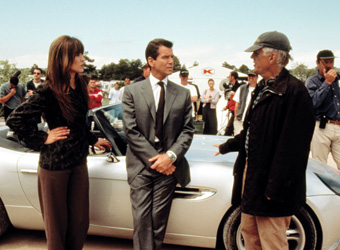 Michael Apted, with Pierce Brosnan and Sophie Marceau, tried to bring something
Michael Apted, with Pierce Brosnan and Sophie Marceau, tried to bring something
of his own to The World is Not Enough while honoring the tradition of the series.
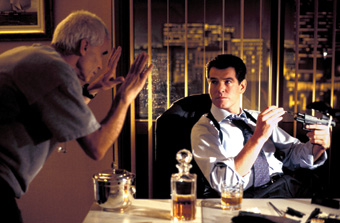
Lee Tamahori frames Pierce Brosnan aiming his gun in Die Another Day.
The director was surprised to find himself in the middle of a Bond movie.
(Photo Credits: Danjaq, LLC and UA Corp)
By the 21st century, though, technological progress was allowing shots that would have been unthinkable just a few years earlier. "In Casino Royale, when Bond jumps from one crane to another and then jumps onto the roof, all in one shot, that would have been a very difficult one to pull off on my first Bond movie," says Campbell. "Now those winches are computer operated, and they absolutely can safely carry the stuntman. And then it's just down to removing the wires digitally. I'm not sure that technology even existed when we did GoldenEye, which was in 1995."
Campbell is a crucial director in the Bond franchise. Not only is he the only director since Glen to do more than one film, but he was on hand for Casino Royale, the 2006 film that not only introduced Daniel Craig as Bond, but was widely credited with revitalizing and restarting the franchise in a harder, less jokey vein.
The move had been coming for a while, with directors as far back as Glen saying they wanted to make the series tougher and less gimmicky. But in the aftermath of the Bourne movies, Campbell got the nod to do a serious reinvention. The director, who had made what he says was an "old Bond" film with GoldenEye, went into Casino Royale with a new Bond and a new approach: rougher fight scenes, more realistic stunts and a less superhuman secret agent.
"He wasn't in any way the James Bond of previous movies, which gave some latitude," Campbell says. "In the free-running sequence, Bond made a pig's ear of it when he jumped. He was always landing badly or knocking himself. In normal Bond films, of course, you couldn't have that. Bond would be as agile, if not more so, than the man he's chasing."
When Marc Forster came on board for Quantum of Solace, he was similarly anxious to jettison the parts of the Bond legacy that didn't appeal to him. "I really wasn't interested in making a Bond movie," says Forster, who'd never worked with a second unit and was best-known for gentler films like Finding Neverland. "But I liked Barbara and Michael, and when I met with Daniel Craig I thought, I can make an interesting movie with this guy. So all the elements I loved in the Bond films, I included; and the ones I didn't, I left out. Bond's gadgets are not as interesting to me, because the gadgetry reminds me more of comic superheroes. So I didn't use any."
If Forster's Bond is a tortured, emotional character, the director also had to face the fact that his leading man does not wear his heart on his sleeve. "I think one of the reasons for the success of the Bond films," he says, "is that Bond is a mystery. I didn't want to psychoanalyze him, but I thought it was important to feel the emotional tissue with him. I just had to think of it as a character piece, and focus on this character and follow his journey."
And that, in a way, is what most Bond directors have found. Sure, the films have big stunts, beautiful women, exotic locations and dastardly villains trying to rule the world via a variety of nefarious schemes. But in the end, they come down to one man:
Bond. James Bond.
"The thing that you have to hang on to, despite the complicated logistics, is that you want to make a character film," says Spottiswoode. "Yes, it's going to have endless action. But at the heart of it, people go because they like Bond. There are always special effects movies that will have more or bigger action scenes—more of this or more of that. But if you get it right, and you get this odd, entertaining English character at the center of it, then it works."